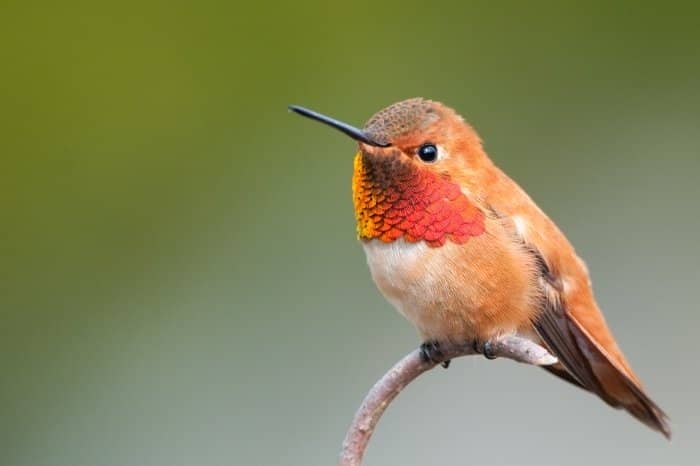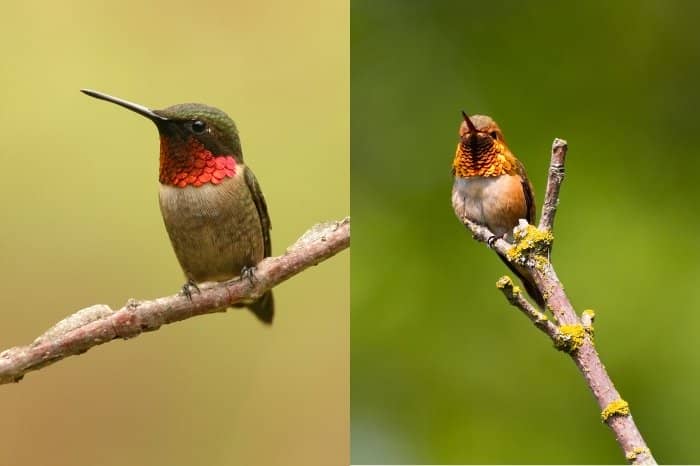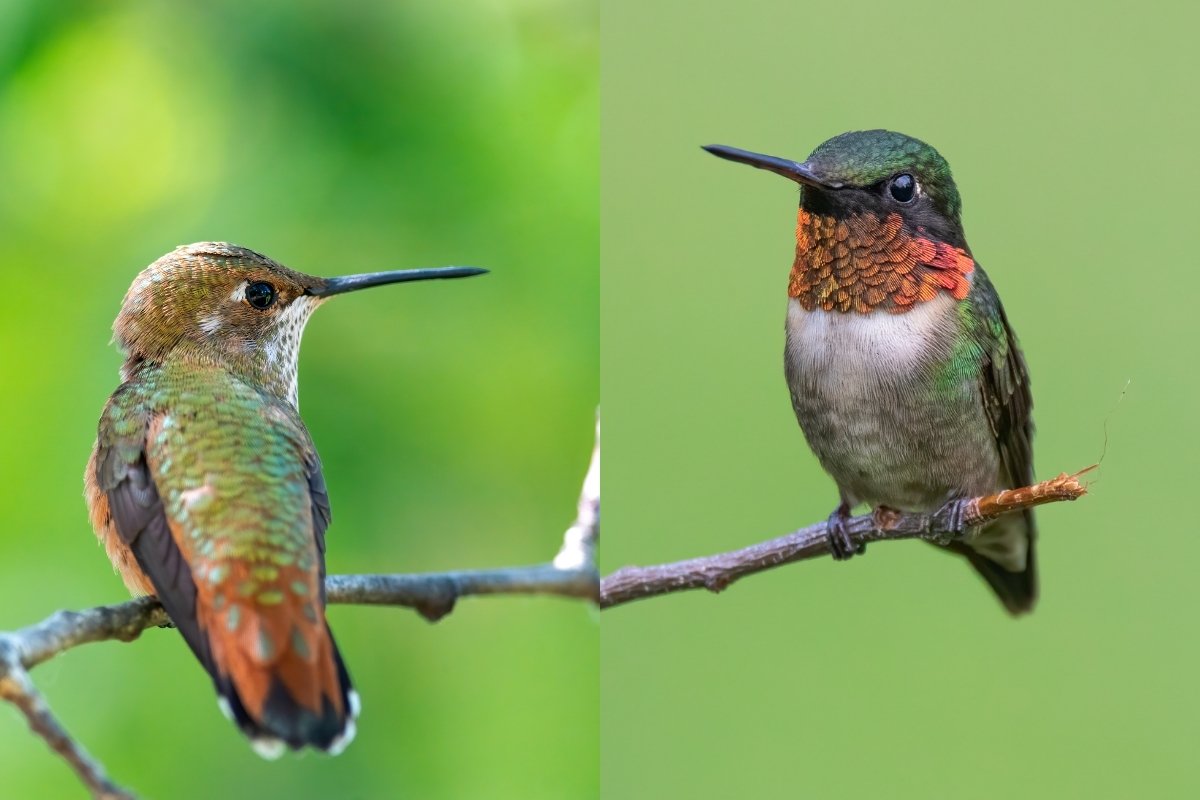The two most common hummingbirds in the US overlap in locations, so sometimes it’s hard to distinguish the Rufous vs Ruby Throated hummingbird. The male hummingbirds from both species have a more colorful plumage, but under different lights, they look alike. They’re similar in size, so it’s even harder to tell them apart.
If you’re an avid birdwatcher, we’re here to help; below, you’ll find 6 ways to recognize the Rufous vs Ruby Throated hummingbird.
The Rufous Hummingbird
The Rufous hummingbird got its name after the marvelous color of its feathers. While most hummingbirds have vivid iridescent colors, the rufous hummingbird has rust-colored feathers that help it blend in with the surrounding.
The most special feature of the Rufous hummingbird is its location preference. They’re the only hummingbirds in the US that nest far up north, even in Alaska! The first Rufous hummingbirds arrive in March and depart at the beginning of fall.

The females begin building their nest less than a week after arriving in the chosen territory. They often choose oak, pine, and rarely ferns for their nest 30 feet above the ground.
But what is the average lifespan of a Rufous hummingbird? Most hummingbirds have an average lifespan of 5 years, but the Rufous defeats the odds. The oldest Rufous hummingbird was almost 9 years old.
Where Can You Spot The Rufous Hummingbird
So where are Rufous Hummingbirds found? Rufous hummingbirds spend spring, summer, and fall in the US. In springtime, you can find the largest number of them in the California region. Summer is reserved for the Pacific Northwest, and in the fall, they move to the Rocky Mountains. From here, they start their journey to Central America, often spending the winter in Mexico.
How To Identify A Rufous Hummingbird
How can you tell if a hummingbird is a Rufous? Rufous hummingbirds are 2.8 to 3.5 inches long and have a wingspan of 4.3 inches. They’re also commonly confused with Allen’s hummingbird due to the size and color.
The small size doesn’t stop this bird from being feisty. Rufous hummingbirds can chase away all other hummingbird species from their territory!
The Mating Ritual Of Rufous Hummingbirds
The mating ritual of Rufous vs Ruby Throated hummingbird is very different. The male Rufous hummingbird flys in oval shapes as soon as a female approaches his territory. He’ll start flying in figure-eight or J shapes to fascinate her even further when she comes closer.
The female lays her eggs for up to 19 days and usually has one brood per season. Are Rufous Hummingbirds rare because of this reason? No, the Rufous hummingbirds are common but are under threat due to the massive destruction of their natural habitat.
National Geographic Backyard Guide to the Birds of North America
The Ruby-Throated Hummingbird
The ruby-throated hummingbird is the first most common hummingbird in the US and one of the few that overwinter here. They dominate a significant territory of eastern North America and nest in open woodlands. The male has a vividly colored gorget while the female is duller to disguise itself better.
Gorget or throat feathers are another clue to look for when telling apart Rufous vs Ruby Throated hummingbird. While both species have brightly colored gorgets, the one on the ruby-throated hummingbird pops up more. This is due to the remaining plumage being paler.
Get to Know about Hummingbird Egg Incubation Period: 3 Thing You Need To Know
Where To Find Ruby-Throated Hummingbirds
You can find Ruby-throated hummingbirds in woodland edges and gardens. They’re plentiful in urban areas and always on the hunt for flower nectar. They mate from May to July and often have more than one brood per season.
Rufous Vs Ruby Throated Hummingbird
Although these species rarely overlap, they might stay in the same area during their migration. If you’re confused about what kind of visitors you’re getting on your feeders, here’s the list of Rufous vs Ruby Throated hummingbird differences.
1. Color
The Rufous hummingbird has a specific brown and orange, a rust-like color that no other hummingbird has. The male has white chest feathers under the orange and green gorget. The female also has some orange hues, but her throat is speckled with green dots.
Ruby-throated hummingbirds are not as specific; they’re green and grey with fuchsia-colored gorget in the males.

2. Tail Shape
The Ruby-throated hummingbird has a fork-like tail, while the Rufous hummingbird has a more round tail. The best time you can notice the difference is when the birds are perched or mid-flight.
3. Size
There’s not a significant difference between rufous vs ruby throated hummingbird when it comes to size. Both birds average around 3 inches in length and 4 inches in wingspan. The males in both species are smaller than the females.
4. Location
Location is the key clue – the breeding territories of these species do not overlap. The Rufous nests from Oregon and up north, while the Ruby-throated hummingbird stays in the east part of North America.
They might overlap on one occasion during their migration to Central America.
5. Migration
Some ruby-throated hummingbirds are known to spend the winters in the US, migrating to Florida to enjoy the warmer winters. Unlike them, all Rufous hummingbirds leave North America by the end of October, so it’s impossible to spot a Rufous hummingbird during the winter.
6. Sound
Sound is another, not as noticeable, difference between rufous vs ruby throated hummingbird. The ruby-throated hummingbird is louder, often chirping for no apparent reason. They also fly faster, so the buzz or hum is more noticeable.
Rufous hummingbirds release loud noises only when they’re threatened or want to chase away another bird.
Bottom Line: Rufous Vs Ruby Throated Hummingbird
Telling apart Rufous vs Ruby Throated hummingbird is much harder for beginners due to the similar size of both birds. While the females of these kinds are much alike, the males have distinct yet vivid colors that make them easier to distinguish.
They prefer to spend the season in different parts of North America, so it’s harder to spot them side by side. On a rare occasion, during the fall migration, these hummingbirds can be spotted together. However, the Rufous is much more aggressive and will chase off other hummingbirds.
FAQ’s
[rank_math_rich_snippet id=”s-a553bf2f-61fc-4bff-8234-9f6b9e9f4e55″]


